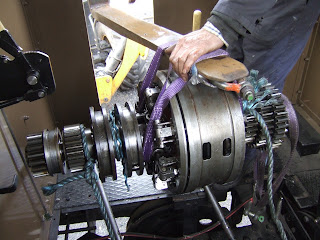The Strathspey Railway held a Rail 200 Event in October 2025. The specail Rail 200 Exhibition train was stationed at Boat of Garten on the 16th and 17th and a Gala Day was held on Saturday 18th featuring an intensive timetable involving all 3 steam locomotives and all 3 main line diesels. Cab rides were also available on Queen Anne and diesel shunter D3605.
Trip to Boat of Garten Monday 13th
After a thorough wash and polish, Queen Anne was towed at a steady pace from Aviemore to Boat of Garten by diesel locomotive 37674 and placed in the bay platform, ready for duties later in the week.
 |
| A shiny Queen Anne in Aviemore ready to go to BoG |
 |
| Queen Anne arrives at BoG |
 |
| The Footplate Crew |
Rail 200 Exhibition Train
Queen Anne played an important part in the visit of the Exhibition Train. Apparently the train coaches have an unusual type of handbrake which can sometimes jam on. To get over this possible problem, they prefer to park the train with the handbrake off and coupled to a locomotive with its own handbrake. Thus the train was placed in the bay platform at the buffer stops and Queen Anne was stationed at the head of the train with its handbrake on. There is a slight gradient toward the buffers so the exhibition train would definitely not be going anywhere.
 |
| Queen Anne at the head of the Exhibition Train |
The Exhibition Train departed on Friday 17th for its next stop at Aberdeen.
Footplate Rides at the Saturday Gala
On the Saturday, Queen Anne was stationed in the now vacant bay platform and provided footplate rides up and down the length of the platform throughout the day. There was no charge but it was suggested that participants could make a voluntary donation for locomotive restoration.
The footplate rides were well received and donations totalling £120 were taken.
 |
| Queen Anne at the Stop Board |
 |
| Ready to return to the buffer stops |
 |
| Footplate Crew |
 |
| Queen Anne and BoG Shunter D2774 |
Here are some videos of the footplate rides :-
Return to Aviemore Monday 20th
One small step for a diesel, one giant leap for Rustonkind....
It was decided that Queen Anne would return to Aviemore under her own power. This certainly would be the longest non-stop trip she has ever made, as the distance is about 5 miles and the rail network at Longmorn distillery was much shorter than that.
Not many Ruston 48DS shunters can have travelled so far in a single journey.
Everything went well and the journey was made in 26 minutes at an average speed of 10 mph, which is the top speed for a 48DS.
This video shows starting up, passing the Kinchurdy foot crossing, going over the level crossing at Dalfaber (Aviemore) and arriving at the yard in Aviemore.
 |
| Back home outside Aviemore Locoshed |















































